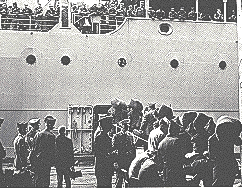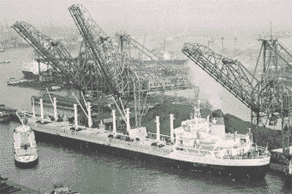Europe: The Second Front
(Military Sea Transportation Service in Europe)By Salvatore R. Mercogliano
In September 1953, with the war in Korea ended, Mavia Cain, Marie A. Myers, Eileen Paluzzi, and Annette Tilloston climbed the gangway of a passenger ship in New York harbor. This was not an unusual occurrence, since many young ladies partook in oceanic voyages, but in this case it was a historic moment. The ship that they were embarking upon was the Military Sea Transportation Service troop transport USNS General Maurice Rose, destined for Europe and docked at the Staten Island Terminal.
On the quarterdeck, the ship's master, Captain Cornelius Powers was accompanied by the Commander of MSTS Atlantic area, and subsequently the third commander of MSTS, Rear Admiral John M. Will. Both these men awaited the arrival of these four distinguished ladies. While MSTS transports routinely carried women on board as passengers, these four were unique in that unlike their predecessors, they were Navy Corpsmen and reporting on board the Rose for permanent assignment.
Soon, 59 others followed them onto other MSTS transports and forever changed the face of the U.S. Navy. This event was indicative of the happening taking place with MSTS and the U.S. Merchant Marine during the early 1950s. While the Korean War had diverted the focus of many, MSTS continued to perform other vital and groundbreaking missions and services in support of the Department of Defense.
MSTS Longest Standing Mission
Many of the senior American military and political leaders viewed the confrontation in Korea as only a precursor for a larger conflict in Europe. Immediately after the end of the Second World War, the U.S. Army reduced its occupation force to just a constabulary with one division assigned to safeguard its occupation zone.
The Berlin Blockade of 1948 and the coup in Czechoslovakia were seen by many as the first steps in an attempt by the Communists in Moscow to dominate the entire continent. On April 4, 1949, the United States became a member of the North Atlantic Treaty Organization and pledged its support to defend the nations of western and southern Europe from aggression.
To accomplish this goal, the Department of Defense began to mobilize a force of soldiers and nuclear-capable bombers for deployment to Europe. The transportation and sustainment of this force became one of the Military Sea Transportation Service ''longest standing missions."
While MSTS and American merchant ships supported United Nation forces in Korea, others performed a similar, yet little heralded mission in the Atlantic. In May 1951, Major General Harlan N. Hartnesson and the staff of the 4th Infantry Division embarked on board the USNS General A. M. Patch for Bremerhaven, Germany as the initial part of the American buildup in NATO. Over the next year, MSTS transported three other divisions to form the core of the NATO multi-national army stationed in western Germany.
In the United States, two other divisions were earmarked as 30-day reinforcements and it was the mission of MSTS to ensure that sufficient ships were available to transport this contingency force if needed. Concurrently, merchant ships, many of them broken out of the National Defense Reserve Fleet, transported over $20 billion worth of cargo to NATO nations under the Mutual Defense Aid Program.
USNS Gordon loads troops at Baltimore for Berlin Crisis, 1962Following the build-up of US forces in Europe, the Department of Defense re-examined the individual replacement system, which kept units in one location but periodically rotated out soldiers. Lieutenant General John E. Dalquist, the Chief of Army Field Forces, decided to implement a policy by which every overseas-deployed unit would be rotated every three years.
Besides the economic motivations to implement this program, this project provided divisional size deployment readiness exercises for units earmarked for Europe. The first phase of this operation, code-named Gyroscope, began when the 10th Infantry Division relieved the 1st Infantry Division in 1956. The initial swap-out entailed the movement of 44,000 troops and dependents, along with 8,500 tons of equipment, all moved on board MSTS and chartered American merchant ships. Gyroscope continued through 1959 with six other division transfers taking place.
When another confrontation over Berlin arose in 1961, MSTS once again responded by transporting elements of two divisions to Europe. Seven troop transports made twenty sailings and deployed over 21,000 soldiers in two months. In 1964, MSTS played a crucial role in Exercise Big Lift.
With the advent of commercial jetliners, the movement of troops overseas by ship diminished in importance but the requirement to transport equipment and fuel still entailed the extensive utilization of sealift. While aircraft of the Military Airlift Command moved troops to Europe, MSTS ships transported the gear for their use. Following the Vietnam War this became a yearly practice for MSC and materialized in the Reforger (Return of Forces to Germany) series of exercises, beginning in 1976.
Coal for the Armed Forces being discharged from a MSTS-chartered freighter in RotterdamMaintenance of Airfields for Strategic Air Command
Another vital element to the defense posture of the armed forces in Europe was the operation and the maintaining of airfields to stage nuclear-capable bombers, and the ever important aerial refuelers, of the U.S. Air Forces Strategic Air Command (SAC). MSTS responded to this requirement by facilitating in the transportation of the necessary personnel and material to construct new bases around the globe.
In the summer of 1951, MSTS ships ventured along the west coast of Greenland in Operation Bluejay to construct the new SAC base at Thule. All over the globe, MSTS offices sprang up to support Air Force bases, from the desert kingdoms of Morocco and Libya, to the Mediterranean nations of Greece and Italy, together with the Pacific rim nations of Japan, Taiwan, and the Philippines. These offices, along with a multitude of individual service representatives in even more remote areas, provided the link necessary to coordinate the arrival of ships that ensured that America's nuclear deterrence remained fully fueled, manned, and ready.
While maintaining America's outposts proved a challenge, MSTS and the American merchant marine were frequently called upon to perform other unusual missions. In 1955, MSTS initiated the most audacious of these when a fleet of over one hundred ships launched a full-fledged assault on the Arctic to establish, construct, and then maintain a ring of radar stations to safeguard the North American continent from attack.
Illustrations from:
Sealift, October 1969, Military Sea Transportation Service, U.S. Government Printing Office, 1969
www.USMM.org is grateful to Professor Salvatore R. Mercogliano for providing this article. Mercogliano is writing his doctoral dissertation about the history of the Merchant Marine, Military Sea Transportation Service and Military Sealift Command.To Boldly Go Where No Fleet Had Gone Before (MSTS in Arctic) by Salvatore R. Mercogliano
Tankers: Fuel for Thought by Salvatore R. Mercogliano
Special Missions of MSTS and MSC by Salvatore R. Mercogliano
MSC Ships of the Line by Salvatore R. Mercogliano
MSTS and MSC Operations Other Than War by Salvatore R. Mercogliano
MSC Ships that Wait by Salvatore R. Mercogliano
Home11/29/00
www.USMM.org ©1998, 1999, 2000 Salvatore R. Mercogliano and. You may quote material on this web page as long as you cite American Merchant Marine at War, www.usmm.org, as the source. You may not use more than a few lines without permission. If you see substantial portions of this page on the Internet or in published material please notify usmm.org @ comcast.net

